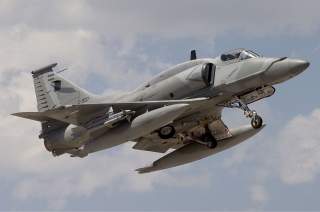Trouble: Argentina's Navy and Air Force Are In Danger
They aren't doing so well.
Key point: Political neglect and falling spending may doom Argentina's power projection capabilities.
The Argentine navy has had a rough few decades. It lost ships and sailors fighting the Royal Navy over the Falkland Islands in 1982. Political upheaval and economic depression robbed it of funding and support. Sanctions constrained modernization efforts. Ships rusted out. Some sank. More sailors died.
Now the Argentine navy is set to lose two more of its larger, oceangoing “blue-water” vessels, potentially shrinking the fleet to just a handful of operational warships that increasingly are suitable only for coastal, “brown-water” missions.
“The Argentine navy is consistently turning from a blue-water navy to a brown-water one,” LATAMilitary reported. “if no corrective measures are taken, this will only continue to fall towards the shoreline.”
As recently as 2017, the Argentine fleet on paper operated around 40 warships together displacing around 120,000 tons of water. These included three submarines of 1970s- and 1980s-vintage, four 1980s-vintage frigates and nine corvettes dating from the ‘70s, ‘80s and 2000s.
But many of the ships were in poor repair and rarely sailed. The destroyer Santisima Trinidad, a survivor of the Falklands War, in 2013 sank at her moorings. Engineers refloated her in 2015, but the 40-year-old vessel was in no condition to return to service. In 2017 the submarine San Juan sank following a battery fire, killing all 44 people aboard.
Then in July 2019 the Argentine navy announced it would scrap the frigate Heroina and the corvette Rosales.
Heroina suffered from post-Falklands sanctions. “An embargo was imposed by the United Kingdom in the aftermath of the South Atlantic conflict of 1982,” LATAMilitary explained, “but as money continued to get to the navy, there was no shortage of spares.”
Decades later, this embargo was being lifted progressively until a diplomatic escalation between Argentine president Cristina Fernandez de Kirchner and [U.K.] prime minister David Cameron produced an export-control resolution by Her Majesty’s Government to limit any import of goods to repair or upgrade and the export of these and/or new products with the Argentine armed forces as the end user, in cases that could be detrimental to the U.K.’s defense and security interests.
Nonetheless, upon improving bilateral relations since the Macri administration took office, a request to lift such a restriction “on a case-by-case criteria” was provisioned by Sir Alan Duncan in June 2018.
This past decade, a critical component of the ship’s gearbox had been damaged, and the navy decided to export it back to the U.K. to be repaired or replaced. It was automatically seized by U.K. Customs and as of yet has not been recovered.
Such a situation combined by the ever-increasing budget cuts left the Heroina stranded at its home port. Right after that, many components and electronics were removed for conservation purposes and even were cannibalized for spares, this is allegedly turning the recommissioning of the frigate both unlikely and costly.
“Something similar happened to the Rosales corvette,” LATAMilitary explained. “Apparently damage to its diesel engines and propeller shafts were deemed costly and complicated to repair, especially after an extensive repair performed on the ARA Espora after she collided with a commercial ship in Bahia Blanca when moored.”
But now the navy plans to dismantle Rosales and several other ships in favor of funding a new class of four, lightly-armed patrol vessels.
The navy isn’t the only Argentine armed service struggling to survive. The air force for years has been trying, and failing, to procure new fighters to replace an aging and shrinking warplane fleet.
British forces in 1982 shot down around a third of Argentina’s 400 warplanes, but in subsequent decades funding woes and mismanagement exacted an even greater toll.
By late 2015 the Argentine air force and navy together could muster fewer than 250 warplanes including a few Vietnam War-vintage, subsonic A-4s and equally aged, but supersonic, French-made Mirages. Even the planes that could fly lacked modern systems.
“The entire air force fleet lacks modern avionics and systems, and still uses analog equipment,” Santiago Rivas wrote in a 2015 edition of Combat Aircraft magazine. “Aircraft have missed out on self-protection equipment, including radar warning receivers, chaff/flare dispensers and so forth.”
The Mirages left service in mid-2015. To rebuild its supersonic fighter capability, Buenos Aires considered buying new Gripens from Brazil, old American F-16s, second-hand Mirage F.1s from Spain, new FC-1s from China and used Israeli Kfir Block 60s, before finally settling on 10 or so FA-50s from South Korea.
David Axe serves as Defense Editor of the National Interest. He is the author of the graphic novels War Fix, War Is Boring and Machete Squad. This first appeared in August 2019.
Image: Wikimedia.

